ESP Alfa Romeo MiTo 2020 Owner handbook (in English)
[x] Cancel search | Manufacturer: ALFA ROMEO, Model Year: 2020, Model line: MiTo, Model: Alfa Romeo MiTo 2020Pages: 212, PDF Size: 5.18 MB
Page 68 of 212
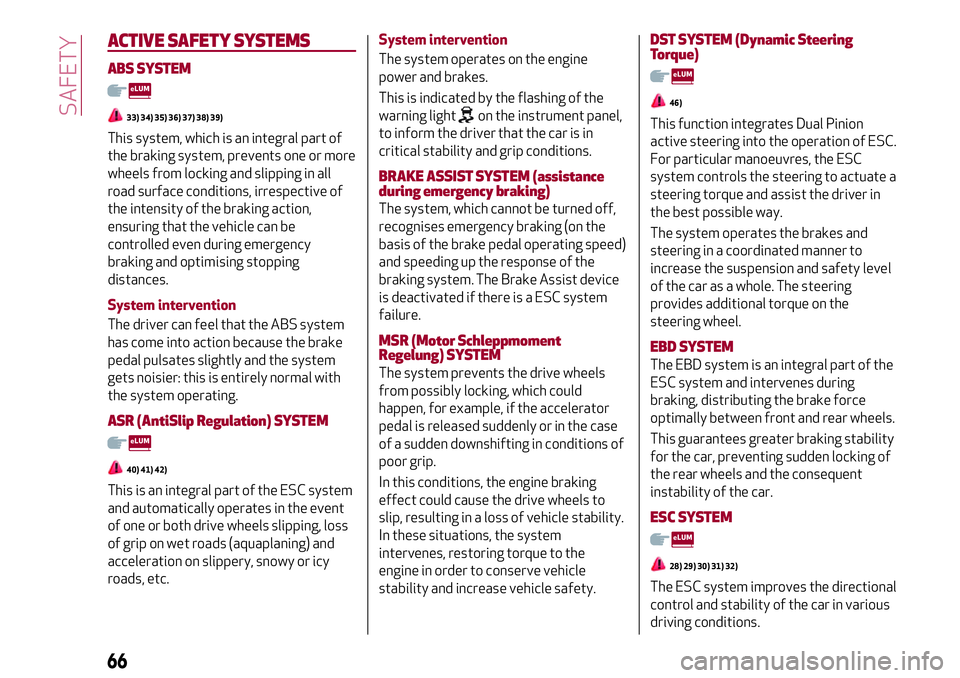
ACTIVE SAFETYSYSTEMS
ABS SYSTEM
33) 34) 35) 36) 37) 38) 39)
This system, which is an integral part of
the braking system, prevents one or more
wheels from locking and slipping in all
road surface conditions, irrespective of
the intensity of the braking action,
ensuring that the vehicle can be
controlled even during emergency
braking and optimising stopping
distances.
System intervention
The driver can feel that the ABS system
has come into action because the brake
pedal pulsates slightly and the system
gets noisier: this is entirely normal with
the system operating.
ASR (AntiSlip Regulation)SYSTEM
40) 41) 42)
This is an integral part of the ESC system
and automatically operates in the event
of one or both drive wheels slipping, loss
of grip on wet roads (aquaplaning) and
acceleration on slippery, snowy or icy
roads, etc.System intervention
The system operates on the engine
power and brakes.
This is indicated by the flashing of the
warning light
on the instrument panel,
to inform the driver that the car is in
critical stability and grip conditions.
BRAKE ASSISTSYSTEM (assistance
during emergency braking)
The system, which cannot be turned off,
recognises emergency braking (on the
basis of the brake pedal operating speed)
and speeding up the response of the
braking system. The Brake Assist device
is deactivated if there is a ESC system
failure.
MSR (Motor Schleppmoment
Regelung)SYSTEM
The system prevents the drive wheels
from possibly locking, which could
happen, for example, if the accelerator
pedal is released suddenly or in the case
of a sudden downshifting in conditions of
poor grip.
In this conditions, the engine braking
effect could cause the drive wheels to
slip, resulting in a loss of vehicle stability.
In these situations, the system
intervenes, restoring torque to the
engine in order to conserve vehicle
stability and increase vehicle safety.
DST SYSTEM (Dynamic Steering
Torque)
46)
This function integrates Dual Pinion
active steering into the operation of ESC.
For particular manoeuvres, the ESC
system controls the steering to actuate a
steering torque and assist the driver in
the best possible way.
The system operates the brakes and
steering in a coordinated manner to
increase the suspension and safety level
of the car as a whole. The steering
provides additional torque on the
steering wheel.
EBD SYSTEM
The EBD system is an integral part of the
ESC system and intervenes during
braking, distributing the brake force
optimally between front and rear wheels.
This guarantees greater braking stability
for the car, preventing sudden locking of
the rear wheels and the consequent
instability of the car.
ESC SYSTEM
28) 29) 30) 31) 32)
The ESC system improves the directional
control and stability of the car in various
driving conditions.
66
SAFETY
Page 69 of 212
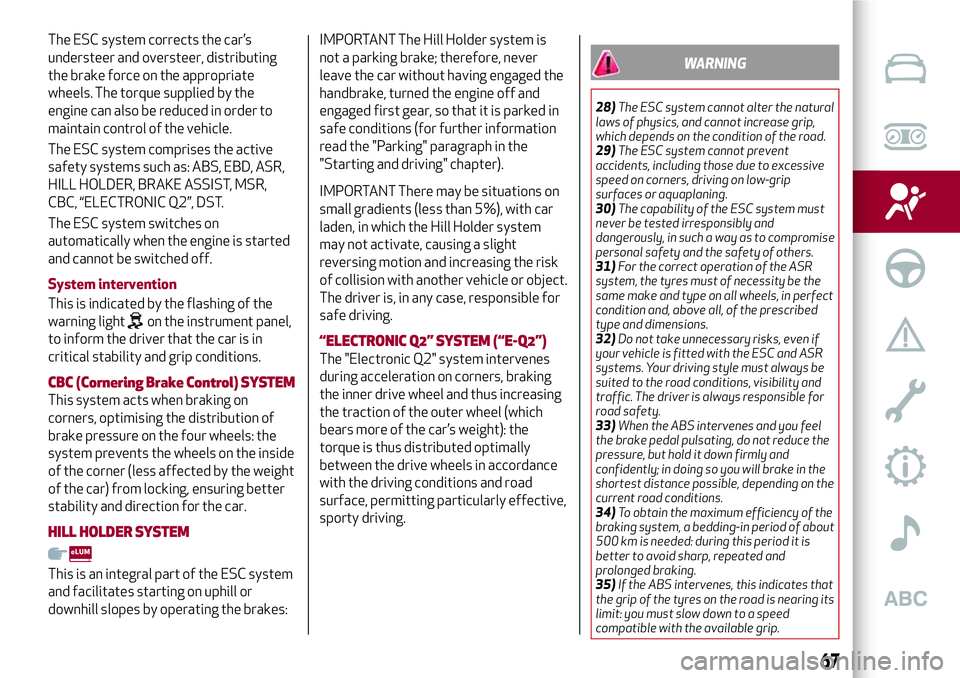
The ESC system corrects the car’s
understeer and oversteer, distributing
the brake force on the appropriate
wheels. The torque supplied by the
engine can also be reduced in order to
maintain control of the vehicle.
The ESC system comprises the active
safety systems such as: ABS, EBD, ASR,
HILL HOLDER, BRAKE ASSIST, MSR,
CBC, “ELECTRONIC Q2”, DST.
The ESC system switches on
automatically when the engine is started
and cannot be switched off.
System intervention
This is indicated by the flashing of the
warning light
on the instrument panel,
to inform the driver that the car is in
critical stability and grip conditions.
CBC (Cornering Brake Control)SYSTEM
This system acts when braking on
corners, optimising the distribution of
brake pressure on the four wheels: the
system prevents the wheels on the inside
of the corner (less affected by the weight
of the car) from locking, ensuring better
stability and direction for the car.
HILL HOLDERSYSTEM
This is an integral part of the ESC system
and facilitates starting on uphill or
downhill slopes by operating the brakes:
IMPORTANT The Hill Holder system is
not a parking brake; therefore, never
leave the car without having engaged the
handbrake, turned the engine off and
engaged first gear, so that it is parked in
safe conditions (for further information
read the "Parking" paragraph in the
"Starting and driving" chapter).
IMPORTANT There may be situations on
small gradients (less than 5%), with car
laden, in which the Hill Holder system
may not activate, causing a slight
reversing motion and increasing the risk
of collision with another vehicle or object.
The driver is, in any case, responsible for
safe driving.
“ELECTRONIC Q2”SYSTEM (“E-Q2”)
The "Electronic Q2" system intervenes
during acceleration on corners, braking
the inner drive wheel and thus increasing
the traction of the outer wheel (which
bears more of the car’s weight): the
torque is thus distributed optimally
between the drive wheels in accordance
with the driving conditions and road
surface, permitting particularly effective,
sporty driving.
WARNING
28)The ESC system cannot alter the natural
laws of physics, and cannot increase grip,
which depends on the condition of the road.
29)The ESC system cannot prevent
accidents, including those due to excessive
speed on corners, driving on low-grip
surfaces or aquaplaning.
30)The capability of the ESC system must
never be tested irresponsibly and
dangerously, in such a way as to compromise
personal safety and the safety of others.
31)For the correct operation of the ASR
system, the tyres must of necessity be the
same make and type on all wheels, in perfect
condition and, above all, of the prescribed
type and dimensions.
32)Do not take unnecessary risks, even if
your vehicle is fitted with the ESC and ASR
systems. Your driving style must always be
suited to the road conditions, visibility and
traffic. The driver is always responsible for
road safety.
33)When the ABS intervenes and you feel
the brake pedal pulsating, do not reduce the
pressure, but hold it down firmly and
confidently; in doing so you will brake in the
shortest distance possible, depending on the
current road conditions.
34)To obtain the maximum efficiency of the
braking system, a bedding-in period of about
500 km is needed: during this period it is
better to avoid sharp, repeated and
prolonged braking.
35)If the ABS intervenes, this indicates that
the grip of the tyres on the road is nearing its
limit: you must slow down to a speed
compatible with the available grip.
67
Page 70 of 212
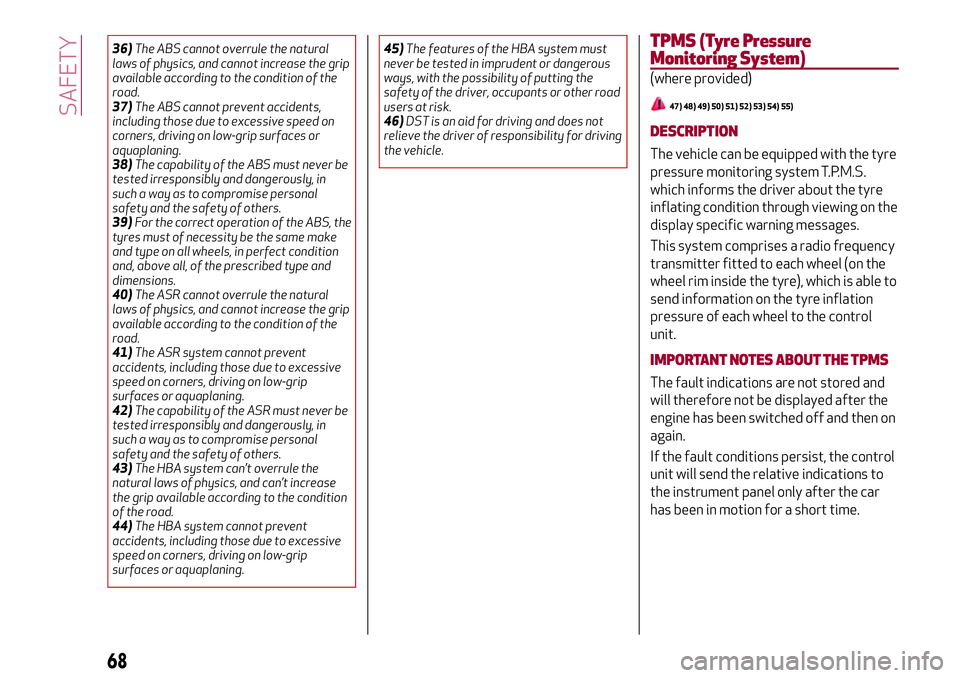
36)The ABS cannot overrule the natural
laws of physics, and cannot increase the grip
available according to the condition of the
road.
37)The ABS cannot prevent accidents,
including those due to excessive speed on
corners, driving on low-grip surfaces or
aquaplaning.
38)The capability of the ABS must never be
tested irresponsibly and dangerously, in
such a way as to compromise personal
safety and the safety of others.
39)For the correct operation of the ABS, the
tyres must of necessity be the same make
and type on all wheels, in perfect condition
and, above all, of the prescribed type and
dimensions.
40)The ASR cannot overrule the natural
laws of physics, and cannot increase the grip
available according to the condition of the
road.
41)The ASR system cannot prevent
accidents, including those due to excessive
speed on corners, driving on low-grip
surfaces or aquaplaning.
42)The capability of the ASR must never be
tested irresponsibly and dangerously, in
such a way as to compromise personal
safety and the safety of others.
43)The HBA system can’t overrule the
natural laws of physics, and can’t increase
the grip available according to the condition
of the road.
44)The HBA system cannot prevent
accidents, including those due to excessive
speed on corners, driving on low-grip
surfaces or aquaplaning.45)The features of the HBA system must
never be tested in imprudent or dangerous
ways, with the possibility of putting the
safety of the driver, occupants or other road
users at risk.
46)DST is an aid for driving and does not
relieve the driver of responsibility for driving
the vehicle.TPMS (Tyre Pressure
Monitoring System)
(where provided)
47) 48) 49) 50) 51) 52) 53) 54) 55)
DESCRIPTION
The vehicle can be equipped with the tyre
pressure monitoring system T.P.M.S.
which informs the driver about the tyre
inflating condition through viewing on the
display specific warning messages.
This system comprises a radio frequency
transmitter fitted to each wheel (on the
wheel rim inside the tyre), which is able to
send information on the tyre inflation
pressure of each wheel to the control
unit.
IMPORTANT NOTES ABOUT THE TPMS
The fault indications are not stored and
will therefore not be displayed after the
engine has been switched off and then on
again.
If the fault conditions persist, the control
unit will send the relative indications to
the instrument panel only after the car
has been in motion for a short time.
68
SAFETY
Page 72 of 212
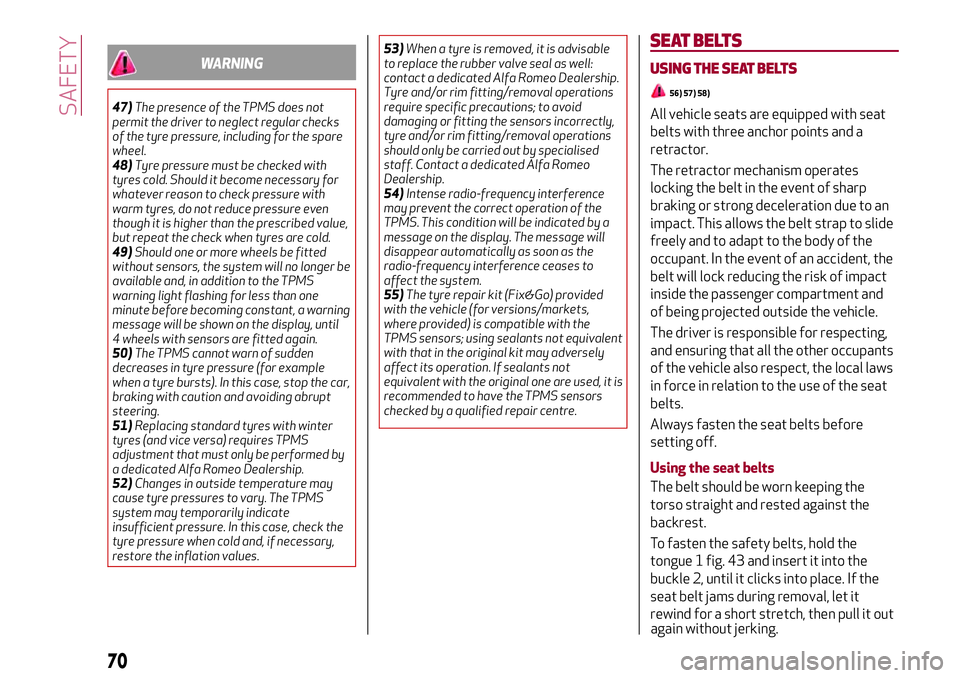
WARNING
47)The presence of the TPMS does not
permit the driver to neglect regular checks
of the tyre pressure, including for the spare
wheel.
48)Tyre pressure must be checked with
tyres cold. Should it become necessary for
whatever reason to check pressure with
warm tyres, do not reduce pressure even
though it is higher than the prescribed value,
but repeat the check when tyres are cold.
49)Should one or more wheels be fitted
without sensors, the system will no longer be
available and, in addition to the TPMS
warning light flashing for less than one
minute before becoming constant, a warning
message will be shown on the display, until
4 wheels with sensors are fitted again.
50)The TPMS cannot warn of sudden
decreases in tyre pressure (for example
when a tyre bursts). In this case, stop the car,
braking with caution and avoiding abrupt
steering.
51)Replacing standard tyres with winter
tyres (and vice versa) requires TPMS
adjustment that must only be performed by
a dedicated Alfa Romeo Dealership.
52)Changes in outside temperature may
cause tyre pressures to vary. The TPMS
system may temporarily indicate
insufficient pressure. In this case, check the
tyre pressure when cold and, if necessary,
restore the inflation values.53)When a tyre is removed, it is advisable
to replace the rubber valve seal as well:
contact a dedicated Alfa Romeo Dealership.
Tyre and/or rim fitting/removal operations
require specific precautions; to avoid
damaging or fitting the sensors incorrectly,
tyre and/or rim fitting/removal operations
should only be carried out by specialised
staff. Contact a dedicated Alfa Romeo
Dealership.
54)Intense radio-frequency interference
may prevent the correct operation of the
TPMS. This condition will be indicated by a
message on the display. The message will
disappear automatically as soon as the
radio-frequency interference ceases to
affect the system.
55)The tyre repair kit (Fix&Go) provided
with the vehicle (for versions/markets,
where provided) is compatible with the
TPMS sensors; using sealants not equivalent
with that in the original kit may adversely
affect its operation. If sealants not
equivalent with the original one are used, it is
recommended to have the TPMS sensors
checked by a qualified repair centre.
SEAT BELTS
USING THE SEAT BELTS
56) 57) 58)
All vehicle seats are equipped with seat
belts with three anchor points and a
retractor.
The retractor mechanism operates
locking the belt in the event of sharp
braking or strong deceleration due to an
impact. This allows the belt strap to slide
freely and to adapt to the body of the
occupant. In the event of an accident, the
belt will lock reducing the risk of impact
inside the passenger compartment and
of being projected outside the vehicle.
The driver is responsible for respecting,
and ensuring that all the other occupants
of the vehicle also respect, the local laws
in force in relation to the use of the seat
belts.
Always fasten the seat belts before
setting off.
Using the seat belts
The belt should be worn keeping the
torso straight and rested against the
backrest.
To fasten the safety belts, hold the
tongue 1 fig. 43 and insert it into the
buckle 2, until it clicks into place. If the
seat belt jams during removal, let it
rewind for a short stretch, then pull it out
70
SAFETY
again without jerking.
Page 74 of 212
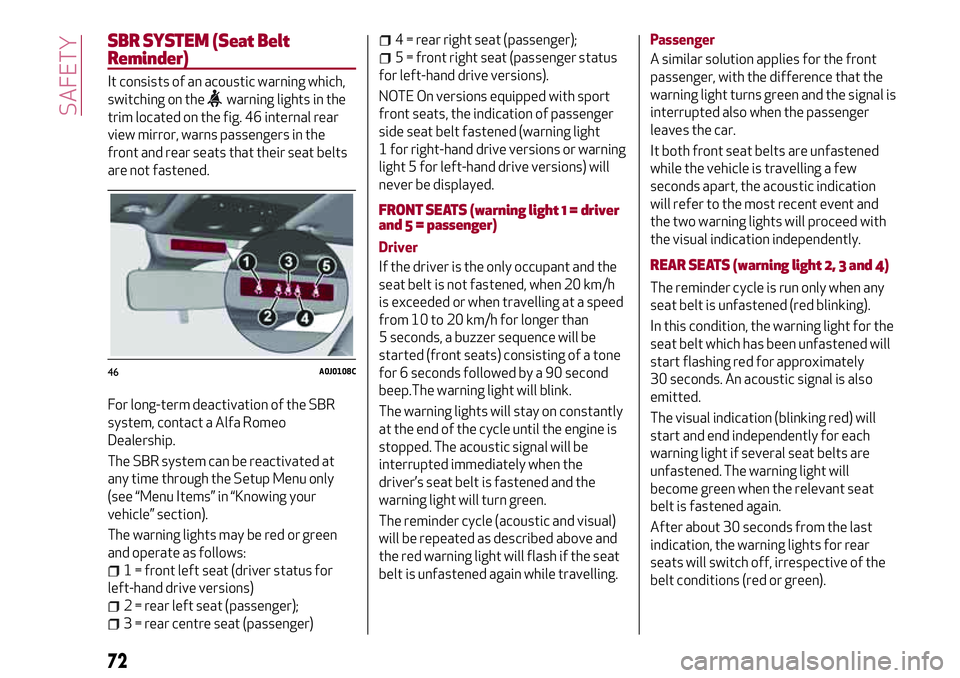
SBR SYSTEM (Seat Belt
Reminder)
It consists of an acoustic warning which,
switching on the
warning lights in the
trim located on the fig. 46 internal rear
view mirror, warns passengers in the
front and rear seats that their seat belts
are not fastened.
For long-term deactivation of the SBR
system, contact a Alfa Romeo
Dealership.
The SBR system can be reactivated at
any time through the Setup Menu only
(see “Menu Items” in “Knowing your
vehicle” section).
The warning lights may be red or green
and operate as follows:
1 = front left seat (driver status for
left-hand drive versions)
2 = rear left seat (passenger);
3 = rear centre seat (passenger)
4 = rear right seat (passenger);
5 = front right seat (passenger status
for left-hand drive versions).
NOTE On versions equipped with sport
front seats, the indication of passenger
side seat belt fastened (warning light
1 for right-hand drive versions or warning
light 5 for left-hand drive versions) will
never be displayed.
FRONT SEATS (warning light 1 = driver
and 5 = passenger)
Driver
If the driver is the only occupant and the
seat belt is not fastened, when 20 km/h
is exceeded or when travelling at a speed
from 10 to 20 km/h for longer than
5 seconds, a buzzer sequence will be
started (front seats) consisting of a tone
for 6 seconds followed by a 90 second
beep.The warning light will blink.
The warning lights will stay on constantly
at the end of the cycle until the engine is
stopped. The acoustic signal will be
interrupted immediately when the
driver’s seat belt is fastened and the
warning light will turn green.
The reminder cycle (acoustic and visual)
will be repeated as described above and
the red warning light will flash if the seat
belt is unfastened again while travelling.Passenger
A similar solution applies for the front
passenger, with the difference that the
warning light turns green and the signal is
interrupted also when the passenger
leaves the car.
It both front seat belts are unfastened
while the vehicle is travelling a few
seconds apart, the acoustic indication
will refer to the most recent event and
the two warning lights will proceed with
the visual indication independently.
REAR SEATS (warning light 2, 3 and 4)
The reminder cycle is run only when any
seat belt is unfastened (red blinking).
In this condition, the warning light for the
seat belt which has been unfastened will
start flashing red for approximately
30 seconds. An acoustic signal is also
emitted.
The visual indication (blinking red) will
start and end independently for each
warning light if several seat belts are
unfastened. The warning light will
become green when the relevant seat
belt is fastened again.
After about 30 seconds from the last
indication, the warning lights for rear
seats will switch off, irrespective of the
belt conditions (red or green).
46A0J0108C
72
SAFETY
Page 78 of 212

66)Do not move the front or rear seat if a
child is seated on it or on the dedicated child
restraint systemFITTING "UNIVERSAL" CHILD
RESTRAINTSYSTEM (with seat
belts)
GROUP 0 and 0+
68) 69) 70) 71) 72)
Babies up to 13 kg must be carried with a
rear facing child restraint system of a
type as shown in fig. 50 which, supporting
the head, does not induce stress on the
neck in the event of sudden
decelerations.
The child restraint system is secured by
the vehicle seat belts, as shown in
fig. 50 and it must restrain the child in
turn with its own belts.
GROUP 1
67) 68) 69) 70) 71) 72)
Children of weight from 9 to 18 kg may
be transported in forward facing child
restraint systems fig. 51.
GROUP 2
68) 69) 70) 71) 72)
Children from 15 to 25 kg may be
restrained directly by the car seat belts
fig. 52.
In this case, the child restraint system is
used to position the child correctly with
respect to the seat belts so that the
diagonal belt section crosses the child’s
50A0K0014C
51A0K0129C
52A0K0016C
76
SAFETY
Page 84 of 212
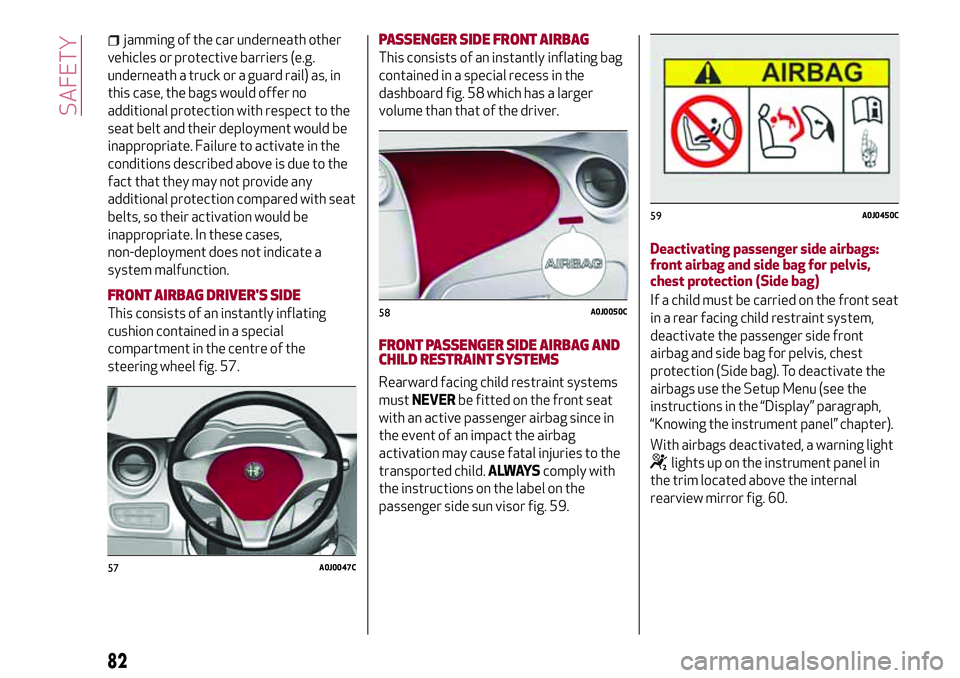
jamming of the car underneath other
vehicles or protective barriers (e.g.
underneath a truck or a guard rail) as, in
this case, the bags would offer no
additional protection with respect to the
seat belt and their deployment would be
inappropriate. Failure to activate in the
conditions described above is due to the
fact that they may not provide any
additional protection compared with seat
belts, so their activation would be
inappropriate. In these cases,
non-deployment does not indicate a
system malfunction.
FRONT AIRBAG DRIVER'S SIDE
This consists of an instantly inflating
cushion contained in a special
compartment in the centre of the
steering wheel fig. 57.
PASSENGER SIDE FRONT AIRBAG
This consists of an instantly inflating bag
contained in a special recess in the
dashboard fig. 58 which has a larger
volume than that of the driver.
FRONT PASSENGER SIDE AIRBAG AND
CHILD RESTRAINTSYSTEMS
Rearward facing child restraint systems
mustNEVERbe fitted on the front seat
with an active passenger airbag since in
the event of an impact the airbag
activation may cause fatal injuries to the
transported child.ALWAYScomply with
the instructions on the label on the
passenger side sun visor fig. 59.Deactivating passenger side airbags:
front airbag and side bag for pelvis,
chest protection (Side bag)
If a child must be carried on the front seat
in a rear facing child restraint system,
deactivate the passenger side front
airbag and side bag for pelvis, chest
protection (Side bag). To deactivate the
airbags use the Setup Menu (see the
instructions in the “Display” paragraph,
“Knowing the instrument panel” chapter).
With airbags deactivated, a warning light
lights up on the instrument panel in
the trim located above the internal
rearview mirror fig. 60.
57A0J0047C
58A0J0050C
59A0J0450C
82
SAFETY
Page 96 of 212
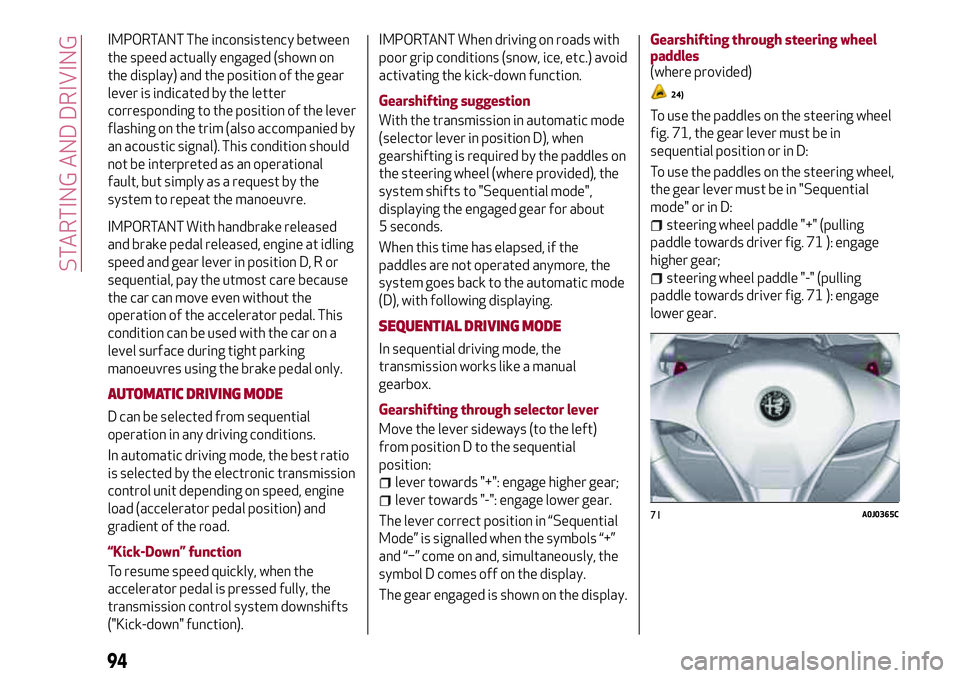
IMPORTANT The inconsistency between
the speed actually engaged (shown on
the display) and the position of the gear
lever is indicated by the letter
corresponding to the position of the lever
flashing on the trim (also accompanied by
an acoustic signal). This condition should
not be interpreted as an operational
fault, but simply as a request by the
system to repeat the manoeuvre.
IMPORTANT With handbrake released
and brake pedal released, engine at idling
speed and gear lever in position D, R or
sequential, pay the utmost care because
the car can move even without the
operation of the accelerator pedal. This
condition can be used with the car on a
level surface during tight parking
manoeuvres using the brake pedal only.
AUTOMATIC DRIVING MODE
D can be selected from sequential
operation in any driving conditions.
In automatic driving mode, the best ratio
is selected by the electronic transmission
control unit depending on speed, engine
load (accelerator pedal position) and
gradient of the road.
“Kick-Down” function
To resume speed quickly, when the
accelerator pedal is pressed fully, the
transmission control system downshifts
("Kick-down" function).
IMPORTANT When driving on roads with
poor grip conditions (snow, ice, etc.) avoid
activating the kick-down function.
Gearshifting suggestion
With the transmission in automatic mode
(selector lever in position D), when
gearshifting is required by the paddles on
the steering wheel (where provided), the
system shifts to "Sequential mode",
displaying the engaged gear for about
5 seconds.
When this time has elapsed, if the
paddles are not operated anymore, the
system goes back to the automatic mode
(D), with following displaying.
SEQUENTIAL DRIVING MODE
In sequential driving mode, the
transmission works like a manual
gearbox.
Gearshifting through selector lever
Move the lever sideways (to the left)
from position D to the sequential
position:
lever towards "+": engage higher gear;
lever towards "-": engage lower gear.
The lever correct position in “Sequential
Mode” is signalled when the symbols “+”
and “−” come on and, simultaneously, the
symbol D comes off on the display.
The gear engaged is shown on the display.Gearshifting through steering wheel
paddles
(where provided)
24)
To use the paddles on the steering wheel
fig. 71, the gear lever must be in
sequential position or in D:
To use the paddles on the steering wheel,
the gear lever must be in "Sequential
mode" or in D:
steering wheel paddle "+" (pulling
paddle towards driver fig. 71 ): engage
higher gear;
steering wheel paddle "-" (pulling
paddle towards driver fig. 71 ): engage
lower gear.
71A0J0365C
94
STARTING AND DRIVING
Page 101 of 212
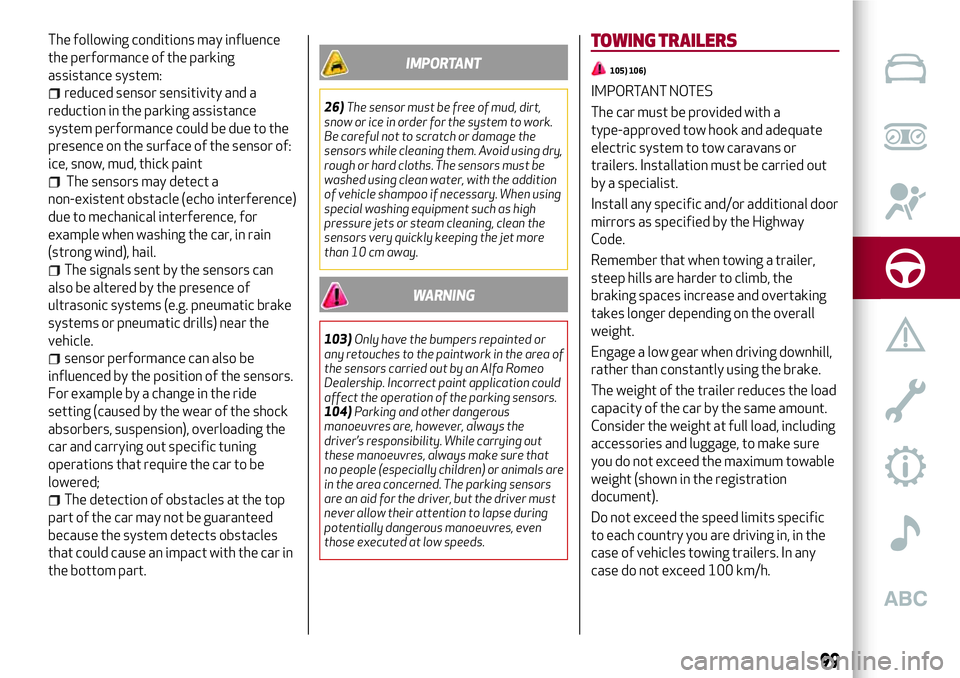
The following conditions may influence
the performance of the parking
assistance system:
reduced sensor sensitivity and a
reduction in the parking assistance
system performance could be due to the
presence on the surface of the sensor of:
ice, snow, mud, thick paint
The sensors may detect a
non-existent obstacle (echo interference)
due to mechanical interference, for
example when washing the car, in rain
(strong wind), hail.
The signals sent by the sensors can
also be altered by the presence of
ultrasonic systems (e.g. pneumatic brake
systems or pneumatic drills) near the
vehicle.
sensor performance can also be
influenced by the position of the sensors.
For example by a change in the ride
setting (caused by the wear of the shock
absorbers, suspension), overloading the
car and carrying out specific tuning
operations that require the car to be
lowered;
The detection of obstacles at the top
part of the car may not be guaranteed
because the system detects obstacles
that could cause an impact with the car in
the bottom part.
IMPORTANT
26)The sensor must be free of mud, dirt,
snow or ice in order for the system to work.
Be careful not to scratch or damage the
sensors while cleaning them. Avoid using dry,
rough or hard cloths. The sensors must be
washed using clean water, with the addition
of vehicle shampoo if necessary. When using
special washing equipment such as high
pressure jets or steam cleaning, clean the
sensors very quickly keeping the jet more
than 10 cm away.
WARNING
103)Only have the bumpers repainted or
any retouches to the paintwork in the area of
the sensors carried out by an Alfa Romeo
Dealership. Incorrect paint application could
affect the operation of the parking sensors.
104)Parking and other dangerous
manoeuvres are, however, always the
driver’s responsibility. While carrying out
these manoeuvres, always make sure that
no people (especially children) or animals are
in the area concerned. The parking sensors
are an aid for the driver, but the driver must
never allow their attention to lapse during
potentially dangerous manoeuvres, even
those executed at low speeds.
TOWING TRAILERS
105) 106)
IMPORTANT NOTES
The car must be provided with a
type-approved tow hook and adequate
electric system to tow caravans or
trailers. Installation must be carried out
by a specialist.
Install any specific and/or additional door
mirrors as specified by the Highway
Code.
Remember that when towing a trailer,
steep hills are harder to climb, the
braking spaces increase and overtaking
takes longer depending on the overall
weight.
Engage a low gear when driving downhill,
rather than constantly using the brake.
The weight of the trailer reduces the load
capacity of the car by the same amount.
Consider the weight at full load, including
accessories and luggage, to make sure
you do not exceed the maximum towable
weight (shown in the registration
document).
Do not exceed the speed limits specific
to each country you are driving in, in the
case of vehicles towing trailers. In any
case do not exceed 100 km/h.
99
Page 106 of 212
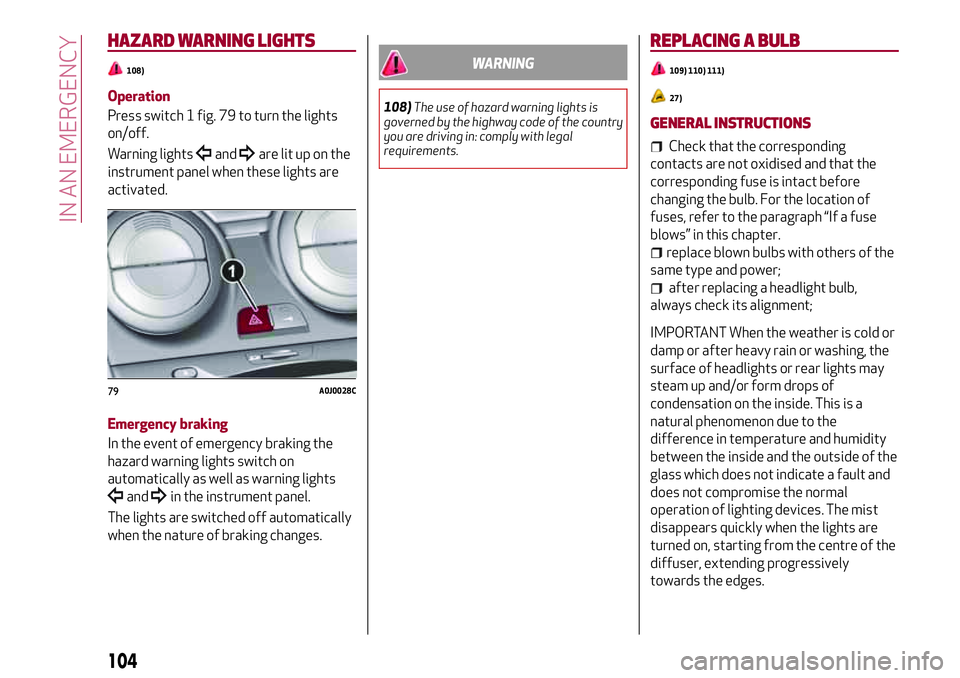
HAZARD WARNING LIGHTS
108)
Operation
Press switch 1 fig. 79 to turn the lights
on/off.
Warning lights
andare lit up on the
instrument panel when these lights are
activated.
Emergency braking
In the event of emergency braking the
hazard warning lights switch on
automatically as well as warning lights
andin the instrument panel.
The lights are switched off automatically
when the nature of braking changes.
WARNING
108)The use of hazard warning lights is
governed by the highway code of the country
you are driving in: comply with legal
requirements.
REPLACING A BULB
109) 110) 111)
27)
GENERAL INSTRUCTIONS
Check that the corresponding
contacts are not oxidised and that the
corresponding fuse is intact before
changing the bulb. For the location of
fuses, refer to the paragraph “If a fuse
blows” in this chapter.
replace blown bulbs with others of the
same type and power;
after replacing a headlight bulb,
always check its alignment;
IMPORTANT When the weather is cold or
damp or after heavy rain or washing, the
surface of headlights or rear lights may
steam up and/or form drops of
condensation on the inside. This is a
natural phenomenon due to the
difference in temperature and humidity
between the inside and the outside of the
glass which does not indicate a fault and
does not compromise the normal
operation of lighting devices. The mist
disappears quickly when the lights are
turned on, starting from the centre of the
diffuser, extending progressively
towards the edges.
79A0J0028C
104
IN AN EMERGENCY